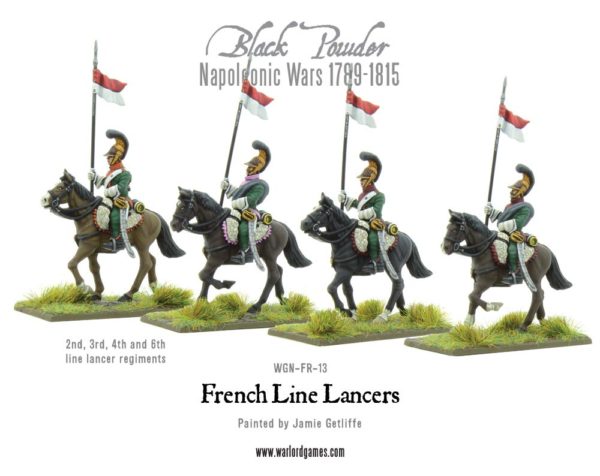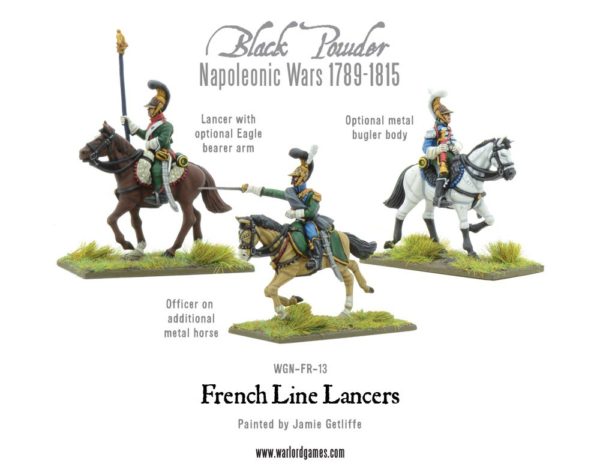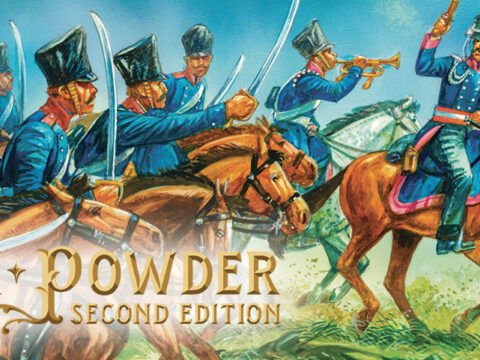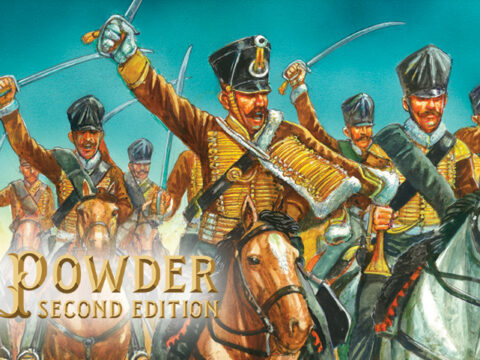Warlord’s own David Matthews takes a look at our plastic Napoleonic French Line Lancers and delves into the background detail of Napoleons Light Horse – The Chevau-Legers Lanciers of the Line:
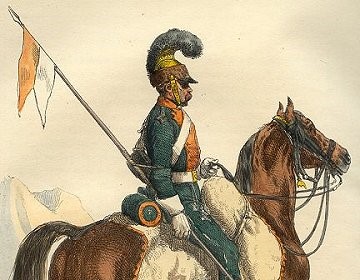
“The Polish lancer, as well as the French lancer distinguished himself by his elegant appearance; but the looks of this last were softer and the colors of his origin moderated, in respect to the military roughness of the first figure. As brave as the Polish lancer, the French lancer had a lively mood”
St. Hilaire
While the history and reputation of the Lancers of the Imperial Guard is well documented, what is not so well known (or, maybe, popular), are the more numerous regiments of the line, named light horse or ‘Chevau-legers’. The other nations named their light cavalry using the term ‘Uhlan’ adulterated from the original Turkish/Tartar Oghln. They differed from the Austrian and Prussian equivalents in their main weapon being the Lance.
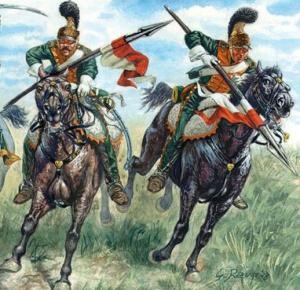
Employed on the battlefield as shock troops they fulfilled a similar role to the more numerous Chasseurs, scouting, pursuit and gathering intelligence, protecting the flanks of the army and threatening the flanks of the opposing force (at Waterloo the lancer brigades deployed to the right and left flank of the line, the right flank being a fortuitous disposition as will become clear later). This ensured the usefulness of the Lancer regiments, as a combination of heavy and light cavalry making a multi-purpose unit.
History
On the 5 and 6 July 1809, north of Vienna, took place one of the most important confrontations in human history until then, the battle of Wagram. An Austrian army led by Archduke Charles faced the French, and allies from Germany and Italy, under the command of Napoleon.
Napoleon in the grip of victory observed the Polish Light Horse pick up Lances discarded by the routing Austrian Uhlans and use them to good effect on the fleeing Austrian infantry and artillery. Impressed by this, Napoleon ordered a squadron of the 3rd Hussars to begin experimental training with the Lance.
Giving lances to poorly trained men
didn’t make them good lancers.
They were rather ‘men with sticks’ than lancers.
Convinced, and with Napoleon’s desire to combat the Russian Cossacks in June 1811 for the forthcoming 1812 campaign, six regiments of Dragoons were converted to lancers. The Vistula Uhlans and the Old Guard Lancers sent their troopers as instructors to the newly formed French units. The Poles at that time were acknowledged to be the finest lancers in Europe.
“It took a lot of extra training to produce a competent lancer. A British training manual produced some years after Waterloo stated that he had to master 55 different exercises with his lance – 22 against cavalry, 18 against infantry, with 15 general ones thrown in for good measure.”
(Adkin – “The Waterloo Companion” p 247)
The 1st, 3rd, 8th, 9th, 10th and 29th Dragoons were converted to 1st, 2nd, 3rd, 4th, 5th, and 6th Lancers. The 7th and 8th Lancers were formed from Poles, by conversion of the 1st and 2nd Vistula Uhlans.
They wore their traditional Polish style uniforms (no helmets). The 9th Regiment was considered also Polish but actually, it was made of Germans and a small number of Poles and Frenchmen. This regiment was formed by conversion of the 30th Chasseurs.
Actions and service
1er Regiment de Chevau-Legers-Lanciers
1812: Smolensk and La Moskowa1813: Dresden, Leipzig, and Hanau.1814: Reims and Paris1815: Waterloo
Battle Honours: None given.
2e Regiment de Chevau-Legers-Lanciers
1812: Moskowa, Winkowo, Beresina, and Wilna 1813: Buntzlau, Katzbach, Bischoffswerda, Weimar, Francfort, Hanau, and Mayence 1814: Rothiere, Montmirail, Vauchamps, Bar-sur-Aube, Troyes, Craonne, Villenauxe, and Fere-Champenoise 1815: Genappes and Waterloo
Battle Honours: None given
3e Regiment de Chevau-Legers-Lanciers
1812: Polotsk and La Beresina 1813: Bautzen, Reichenbach, Dresden, Leipzig, and Hanau 1814: Champaubert, Vauchamps, and Troyes 1815: Ligny and Waterloo
Battle Honours Polotsk 1812, Bautzen 1813, Dresde 1813 and Champaubert 1814
4e Regiment de Chevau-Legers-Lanciers
1812: La Moskowa, Mojaisk, and Winkowo 1813: Leipzig and Hanau 1814: Champaubert and Vauchamps
1815: Waterloo and Fleurus
Battle Honours La Moskowa 1812, Hanau 1813, Vauchamps 1814, and Fleurus 1815
5e Regiment de Chevau-Legers-Lanciers
1812: La Moskowa and Winkowo 1813: Wachau and Hanau. 1814: Montmirail 1815: Ligny and Waterloo
Battle Honours La Moskowa 1812, Bautzen 1813, Dresden 1813, and Champaubert 1814
6e Regiment de Chevau-Legers-Lanciers
1812: Krasnoe, Smolensk, Valoutina, La Moskowa, Wiasma, and La Beresina 1813: Jauer, Leipzig, and Hanau
1814: Champaubert, Montmirail, Vauchamps, Arcis-sur-Aube, and Saint-Dizier 1815: Fleurus and Waterloo
Battle Honours La Moskowa 1812, Hanau 1813, Champaubert 1814, and Fleurus 1815
7e Regiment de Chevau-Legers-Lanciers
1811: Spain 1812: No specific actions given 1813: Magdebourg, Dresden, Naumbourg, and Hanau
1814: Montereau, Neuilly-Saint-Front, Chalons, and Chartres
Battle Honours: None given
8e Regiment de Chevau-Legers-Lanciers
1812: Jakubowo, Polotsk, and La Beresina 1813: Lutzen, Bautzen, Dresden, and Leipzig 1814: Champaubert
Battle Honours Polostk 1812, Bautzen 1813, Dresde 1813, and Champaubert 1814
9e Regiment de Chevau-Legers-Lanciers
1812: Witepsk, Ostrowno, La Moskowa, and La Beresina 1813: Mockern and Kulm 1814: Vauchamps
Battle Honours: None given.
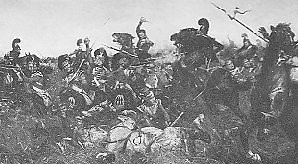
The lancers of the Vistula legion, soon to become the 7th and 8th of the line were part of Latour -Maubourg’s command at Albuera in 1811. Watching the discomfort of the V Corps being ripped apart by the artillery of Cleeves’ KGL, they noticed the British brigade of Colborne suddenly wheel out of line to finish the French and present an open flank. Without hesitation the order was given and the two Vistula regiments, followed by the 2nd Hussars, 10th Hussars, and the 20th Dragoons swept through the sudden cloudburst of rain into Colbourne’s men. The entire British brigade disintegrated – the poles captured several cannon, colours, and hundreds of prisoners.
In 1815 at Quatre Bras the lancers again created havoc among the Netherlands and British troops.
Neys lancers broke the 42nd’s square, routed the 44th and hit the Hanoverian Verdan Battalion whilst forming square, this battalion basically then ceased to exist.
Then at Waterloo the blown horses and disorganized cavalry of the Union Brigade met their fate at the points of Jaquinot’s Lancer brigade, stationed on the French right wing. Fate had given the Lancers their day of glory at the expense of the proud Union Brigade.
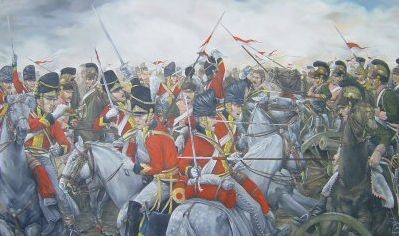
Weapons and Organisation
The lance is 9ft1in (275cm) long and its shaft is made of hardwood such as ash and steel. The bottom has a steel ‘shoe’ to protect the wood when the lance was rested on the ground. The centre of the shaft has a whitened leather grip and a loop for the fingers called a martingale. The lance was decorated with a small red and white flag called a pennon. The steel point was made with a flattened diamond section which allowed it to easily penetrate an enemy soldier’s body. It is secured by long steel straps called langets which made it harder to chop off the point with a sword.

Armed also with sabres and carbines the Regiments only issued the lances to the front rank in the individual squadrons.
In 1813 the 125-men strong company of French lancers was armed as
1st rank
. . . . . . . 2 sergeants each with a saber and 2 pistols
. . . . . . . 4 corporals each with a saber, 1 pistol, musketoon with bayonet and lance
. . . . . . . 44 troopers each with a saber, 1 pistol and a lance
2nd rank
. . . . . . . 4 corporals each with a saber, 1 pistol, and a musketoon with bayonet
. . . . . . . 44 troopers each with a saber, 1 pistol, and a musketoon with bayonet
Supernumerary rank
. . . . . . . 1 sergeant-major, 1 farrier and 2 sergeants each with a saber and 2 pistols
. . . . . . . 3 trumpeters, and 2 farriers each with a saber and 1 pistol
. . . . . . . 9 troopers each with a saber and a carbine
. . . . . . . 9 troopers each with a saber and a lance
(Total of 125 sabers, 109 pistols, 57 lances, 52 musketoons with bayonets and 9 carbines.)
Regimental Organisation consisted of 4 squadrons, each of 2 companies, the 1st squadron having 1 company of elite troopers, and 1 regular company. There were also 2 non-combatant depot squadrons.
1st squadron: 1st (elite) and 5th companies
2nd squadron 2nd and 6th companies
3rd squadron 3rd and 7th companies
4th squadron 4th and 8th companies
Uniforms and Facings
The uniform of the light cavalry (or chevau-legers) of the line consisted of a green Spencer coats and breaches with turnbacks and lapels of the regimental facing color, which could be crimson, red, blue, pink or yellow. The collar and cuffs were of the facings color, the green shoulder straps and the breeches were piped with the facing color.
The uniform comprised pewter buttons, black boots, a brass Carabinier style helmet with a brass crest supporting a woollen comb over a sealskin turban (a result of the previous dragoon role), black leather visor, brass chin scales and red epaulettes for elite companies.
The full dress uniform had the facing colour on the front lapels of the jacket however on campaign green light cavalry overalls were worn with the facing colour on collar and cuffs. Normal light cavalry horse furniture being standard, with a sheepskin over the pistol holsters and the blanket in the regiments facing colour, (see the chasseur a cheval article).
The only variation on this were the 7th,8th and the mainly German 9th regiments that wore blue coats, white epaulettes and a blue polish czapka. Musicians had reversed colour schemes until 1812 when the Green-coat for infantry musicians was introduced.
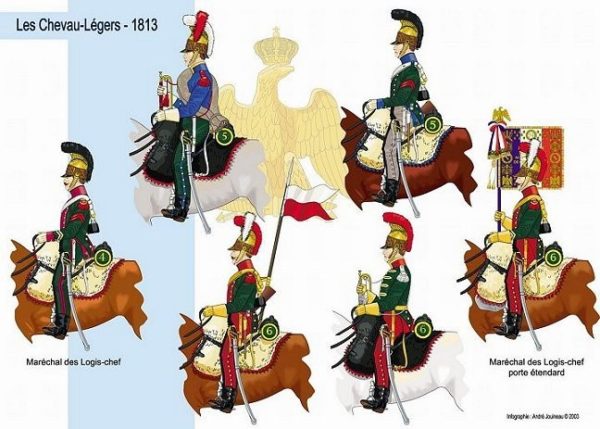
The relevant facing colours for the regiments are:
| Regiment | Colour | Facings on which worn |
| 1st | Scarlet | Collar, cuffs, turn backs, piping, breeches stripe |
| 2nd | Lt Orange | Collar, cuffs, turn backs, piping, breeches stripe |
| 3rd | Pink | Collar, cuffs, turn backs, piping, breeches stripe |
| 4th | Crimson | Collar, cuffs, turn backs, piping, breeches stripe |
| 5th | Sky | Blue Collar, cuffs, turn backs, piping, breeches stripe |
| 6th | Madder Red | Collar, cuffs, turn backs, piping, breeches stripe |
| 7th | Yellow | Collar, cuffs, turn backs, piping, breeches stripe |
| 8th | Yellow with Blue | Collar Collar (Blue), cuffs, turn backs, piping, breeches stripes. |
| 9th | Buff | Collar, cuffs, turn backs, piping, breeches stripe |
Horses
During peacetime the regiments of light and line cavalry had colour of horses according to squadron: this would have been the same for the lancers and their previous guise as Dragoons.
I Squadron: 1st ‘elite’ company rode on blacks, 5th company on browns and blacks
II Squadron: 2nd company rode on bays, 6th company on bays
III Squadron: 3rd company on chestnuts, 7th company on chestnuts
IV Squadron: 4th and 8th company on greys and whites
However, by 1805 only some colonels insisted on keeping up these peacetime practices.
John Elting wrote about the horse care in French cavalry:
“Too many French were careless horse masters, turning their animals loose at night into fields of green grain or clover without supervision. Thousands overate and died of the colic. Germans and Poles were more careful.”
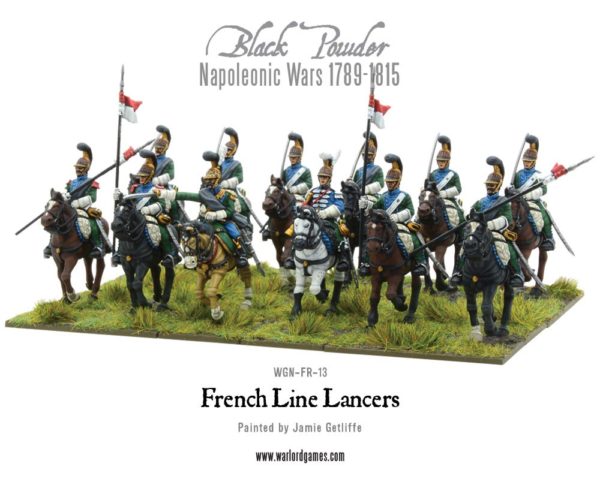
Further Reading:
Elting – “Swords Around a Throne”
Elting – “Napoleonic Uniforms” (superb book)
Hourtoulle – “Soldiers and Uniforms of the Napoleonic Wars”
Haythornthwaite – “Uniforms of Napoleon’s Russian Campaign”
Bukhari-“napoleons cavalry” (courtesy of John Stallard)
Oliver & Partridge- “Napoleonic Handbook II France and her allies.”
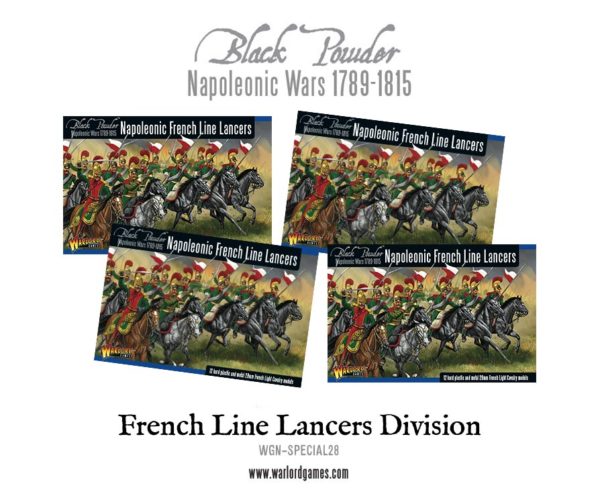
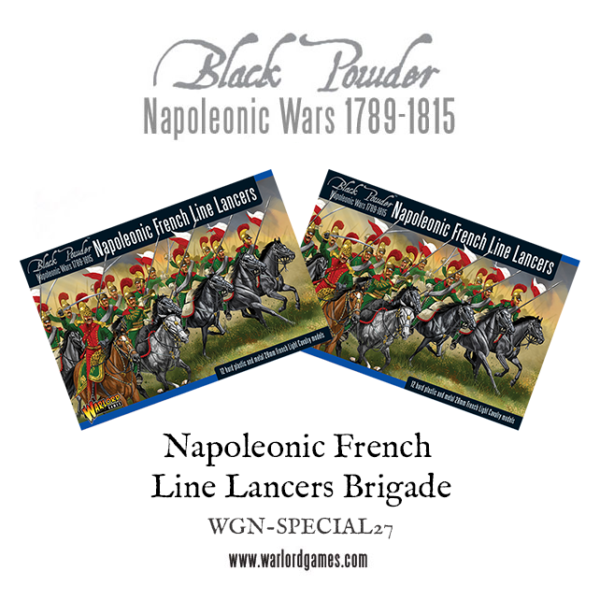
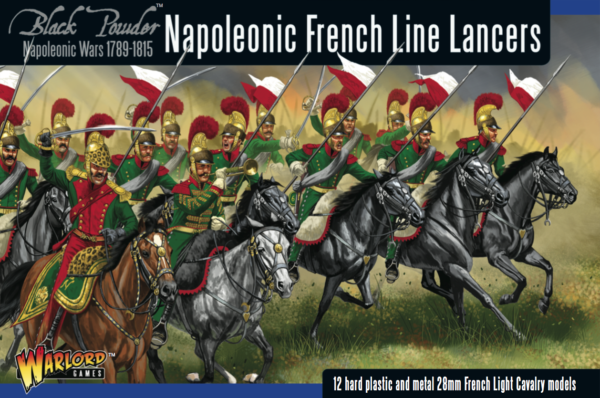
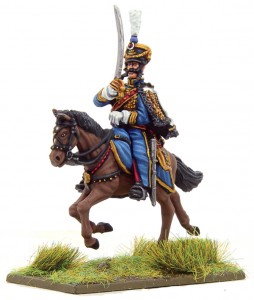
Hussar!

